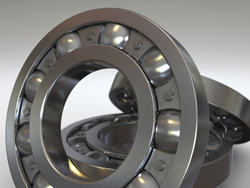New nanocoats reduce friction and pollution
The multidisciplinary consortium team combined electrochemistry, hydrodynamics, reaction kinetics, co-deposition mechanisms, material science and engineering to form novel coatings based on molybdenum disulphide/tungsten disulphide (MoS2/WS2). The nanocomposite coatings were developed using low-cost electrodeposition of cobalt-tungsten (Co-W) alloys impregnated with MoS2 and tungsten carbide (WC). Applying the new processes and materials will achieve a high degree of hardness and mechanical strength conferred by the WC particles and self-lubrication from the MoS2 particles in a Co-W matrix. The overall aim of Nanocoat was to develop new coatings that would be viable alternatives to hard chrome. The new coatings have intrinsic self-lubrication properties so do not have to use liquid lubricants, notorious pollutants. Significant deliverables achieved include thin MoSx coatings containing fullerenes, nanotubes and nano-ribbons on nickel phosphide (NiP) and Co-W substrates by electrodeposition. Simultaneous electrodeposition of Co-W alloy and WC and MoS2 particles formed Co-W-WC nanocomposite coatings. Incorporation of WC particles into the Co-W matrix was found to have a profound influence on wear and corrosion resistance properties and a moderate improvement in hardness. Further work was planned to further incorporate fullerene-like (IF)-MoS2 into a Co-W matrix which should add to the capacity to lubricate. This will potentially reduce further the coefficient of friction and the wear volume. Nanocoat has achieved its goal of producing superior coatings for industrial processes that confer improvements in wear, corrosion and friction coefficient. An added bonus is that, unlike liquid lubricants, the release of toxic chemicals to the environment can be avoided.







